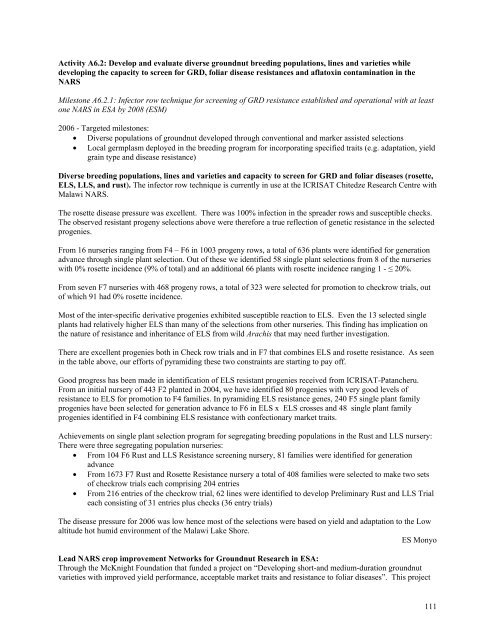ICRISAT Archival Report 2006 - The seedlings of success in the ...
ICRISAT Archival Report 2006 - The seedlings of success in the ...
ICRISAT Archival Report 2006 - The seedlings of success in the ...
You also want an ePaper? Increase the reach of your titles
YUMPU automatically turns print PDFs into web optimized ePapers that Google loves.
Activity A6.2: Develop and evaluate diverse groundnut breed<strong>in</strong>g populations, l<strong>in</strong>es and varieties while<br />
develop<strong>in</strong>g <strong>the</strong> capacity to screen for GRD, foliar disease resistances and aflatox<strong>in</strong> contam<strong>in</strong>ation <strong>in</strong> <strong>the</strong><br />
NARS<br />
Milestone A6.2.1: Infector row technique for screen<strong>in</strong>g <strong>of</strong> GRD resistance established and operational with at least<br />
one NARS <strong>in</strong> ESA by 2008 (ESM)<br />
<strong>2006</strong> - Targeted milestones:<br />
• Diverse populations <strong>of</strong> groundnut developed through conventional and marker assisted selections<br />
• Local germplasm deployed <strong>in</strong> <strong>the</strong> breed<strong>in</strong>g program for <strong>in</strong>corporat<strong>in</strong>g specified traits (e.g. adaptation, yield<br />
gra<strong>in</strong> type and disease resistance)<br />
Diverse breed<strong>in</strong>g populations, l<strong>in</strong>es and varieties and capacity to screen for GRD and foliar diseases (rosette,<br />
ELS, LLS, and rust). <strong>The</strong> <strong>in</strong>fector row technique is currently <strong>in</strong> use at <strong>the</strong> <strong>ICRISAT</strong> Chitedze Research Centre with<br />
Malawi NARS.<br />
<strong>The</strong> rosette disease pressure was excellent. <strong>The</strong>re was 100% <strong>in</strong>fection <strong>in</strong> <strong>the</strong> spreader rows and susceptible checks.<br />
<strong>The</strong> observed resistant progeny selections above were <strong>the</strong>refore a true reflection <strong>of</strong> genetic resistance <strong>in</strong> <strong>the</strong> selected<br />
progenies.<br />
From 16 nurseries rang<strong>in</strong>g from F4 – F6 <strong>in</strong> 1003 progeny rows, a total <strong>of</strong> 636 plants were identified for generation<br />
advance through s<strong>in</strong>gle plant selection. Out <strong>of</strong> <strong>the</strong>se we identified 58 s<strong>in</strong>gle plant selections from 8 <strong>of</strong> <strong>the</strong> nurseries<br />
with 0% rosette <strong>in</strong>cidence (9% <strong>of</strong> total) and an additional 66 plants with rosette <strong>in</strong>cidence rang<strong>in</strong>g 1 - ≤ 20%.<br />
From seven F7 nurseries with 468 progeny rows, a total <strong>of</strong> 323 were selected for promotion to checkrow trials, out<br />
<strong>of</strong> which 91 had 0% rosette <strong>in</strong>cidence.<br />
Most <strong>of</strong> <strong>the</strong> <strong>in</strong>ter-specific derivative progenies exhibited susceptible reaction to ELS. Even <strong>the</strong> 13 selected s<strong>in</strong>gle<br />
plants had relatively higher ELS than many <strong>of</strong> <strong>the</strong> selections from o<strong>the</strong>r nurseries. This f<strong>in</strong>d<strong>in</strong>g has implication on<br />
<strong>the</strong> nature <strong>of</strong> resistance and <strong>in</strong>heritance <strong>of</strong> ELS from wild Arachis that may need fur<strong>the</strong>r <strong>in</strong>vestigation.<br />
<strong>The</strong>re are excellent progenies both <strong>in</strong> Check row trials and <strong>in</strong> F7 that comb<strong>in</strong>es ELS and rosette resistance. As seen<br />
<strong>in</strong> <strong>the</strong> table above, our efforts <strong>of</strong> pyramid<strong>in</strong>g <strong>the</strong>se two constra<strong>in</strong>ts are start<strong>in</strong>g to pay <strong>of</strong>f.<br />
Good progress has been made <strong>in</strong> identification <strong>of</strong> ELS resistant progenies received from <strong>ICRISAT</strong>-Patancheru.<br />
From an <strong>in</strong>itial nursery <strong>of</strong> 443 F2 planted <strong>in</strong> 2004, we have identified 80 progenies with very good levels <strong>of</strong><br />
resistance to ELS for promotion to F4 families. In pyramid<strong>in</strong>g ELS resistance genes, 240 F5 s<strong>in</strong>gle plant family<br />
progenies have been selected for generation advance to F6 <strong>in</strong> ELS x ELS crosses and 48 s<strong>in</strong>gle plant family<br />
progenies identified <strong>in</strong> F4 comb<strong>in</strong><strong>in</strong>g ELS resistance with confectionary market traits.<br />
Achievements on s<strong>in</strong>gle plant selection program for segregat<strong>in</strong>g breed<strong>in</strong>g populations <strong>in</strong> <strong>the</strong> Rust and LLS nursery:<br />
<strong>The</strong>re were three segregat<strong>in</strong>g population nurseries:<br />
• From 104 F6 Rust and LLS Resistance screen<strong>in</strong>g nursery, 81 families were identified for generation<br />
advance<br />
• From 1673 F7 Rust and Rosette Resistance nursery a total <strong>of</strong> 408 families were selected to make two sets<br />
<strong>of</strong> checkrow trials each compris<strong>in</strong>g 204 entries<br />
• From 216 entries <strong>of</strong> <strong>the</strong> checkrow trial, 62 l<strong>in</strong>es were identified to develop Prelim<strong>in</strong>ary Rust and LLS Trial<br />
each consist<strong>in</strong>g <strong>of</strong> 31 entries plus checks (36 entry trials)<br />
<strong>The</strong> disease pressure for <strong>2006</strong> was low hence most <strong>of</strong> <strong>the</strong> selections were based on yield and adaptation to <strong>the</strong> Low<br />
altitude hot humid environment <strong>of</strong> <strong>the</strong> Malawi Lake Shore.<br />
ES Monyo<br />
Lead NARS crop improvement Networks for Groundnut Research <strong>in</strong> ESA:<br />
Through <strong>the</strong> McKnight Foundation that funded a project on “Develop<strong>in</strong>g short-and medium-duration groundnut<br />
varieties with improved yield performance, acceptable market traits and resistance to foliar diseases”. This project<br />
111

















